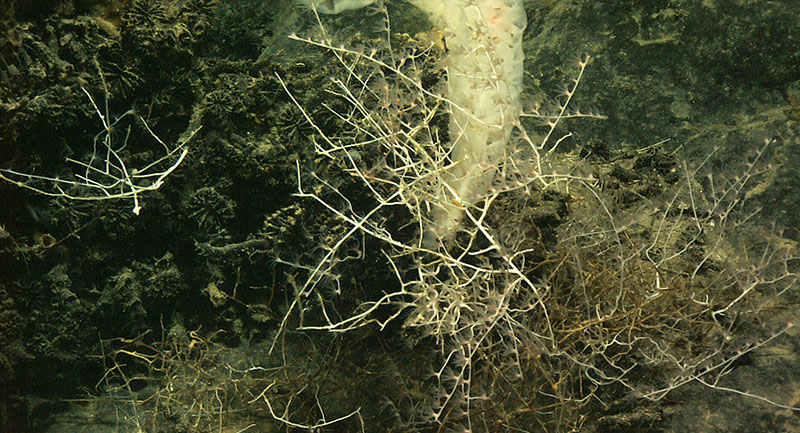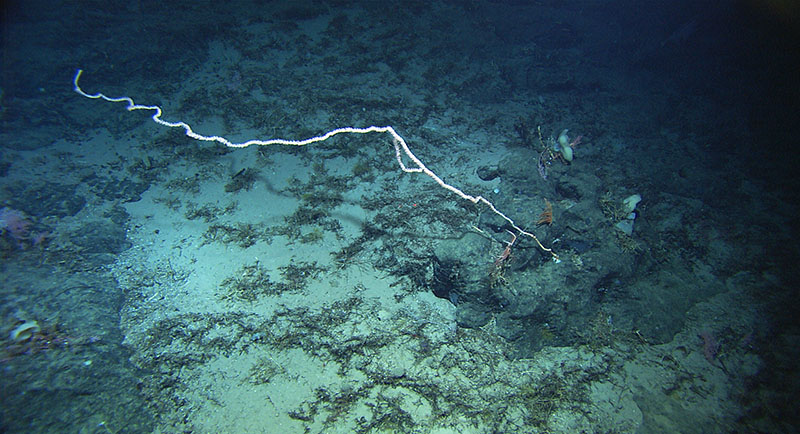
by Les Watling, University of Hawaii at Manoa
June 23, 2019
This video, collected during Dive 3 of the expedition, highlights the bamboo corals seen along the Stetson Mesa South Scarp. Bamboo corals are members of the group called octocorals, meaning they have polyps with eight tentacles. A close up the corals shows particles in the water column that the corals are potentially feeding on. Video courtesy of the NOAA Office of Ocean Exploration and Research, Windows to the Deep 2019. Download larger version (mp4, 87.6 MB).
When someone mentions deep-sea corals, most people think of something like what they might see on a tropical shallow coral reef. But many deep-sea corals, like the colonies in this video, are more closely related to tropical sea fans than to the corals that create the structure of the reef.
One of the most common deep-sea corals are called bamboo corals. These corals get their name from the (admittedly slight) resemblance they have to bamboo stalks. That is, their skeleton is composed of little black “nodes” separated by the white “internodes.” The earliest bamboo corals pulled up by dredges in the 1800s were missing a lot of the living tissue, so the skeleton was more visible than what we see in the remotely operated vehicle (ROV) images of living colonies.
So, what kind of bamboo coral is in this video? Unfortunately, we can’t say because it has most likely not been named and described, and perhaps has not even been seen before. When I started working on the taxonomy of this group about 15 years ago, most of the names were from more than 100 years ago. We have now collected more than 300 specimens from ocean exploration cruises dating back to 2004. The result is that we have a very large number of previously unknown species that are in need of naming and describing.

This bamboo coral is from a Nashville seamount Deep Atlantic Stepping Stones expedition in 2005. It is shows the sprawling extent of the bramble form and tends to be found where there is dead, almost fossilized, hard corals. Image courtesy of the Deep Atlantic Stepping Stones Science Party, IFE, URI-IAO, and NOAA. Download larger version (jpg, 2.1 MB).
Bamboo corals can grow in a large variety of different colony forms. Most common are unbranched colonies, called “whips,” but there are also bushes, fans, and colonies that live close to the ground that we call “brambles.” The colony in this video has a classic fan shape. The colony doesn’t have a strong main axis, instead, branches produce other branches over and over.

This is a bamboo coral from Kelvin seamount during Mountains in the Sea II expedition in 2004. This whip form is about 4 meters (13 feet) in length, but we have seen some that are 5 meters (16.4 feet) long, usually with a lot of curling of the axis at the top. This colony shows what might be one branch, which sometimes is present, but it can also be another individual that has settled on the main colony. Image courtesy of NOAA Office of Ocean Exploration and Research, Mountains in the Sea. Download larger version (jpg, 2.2 MB).
Bamboo corals are members of the group of corals called octocorals. The polyps have eight tentacles armed with little side branches called pinnules that are characteristic of octocorals. There are many groups of octocorals in the deep sea, and most inspire awe in people who are watching the dive over the internet.